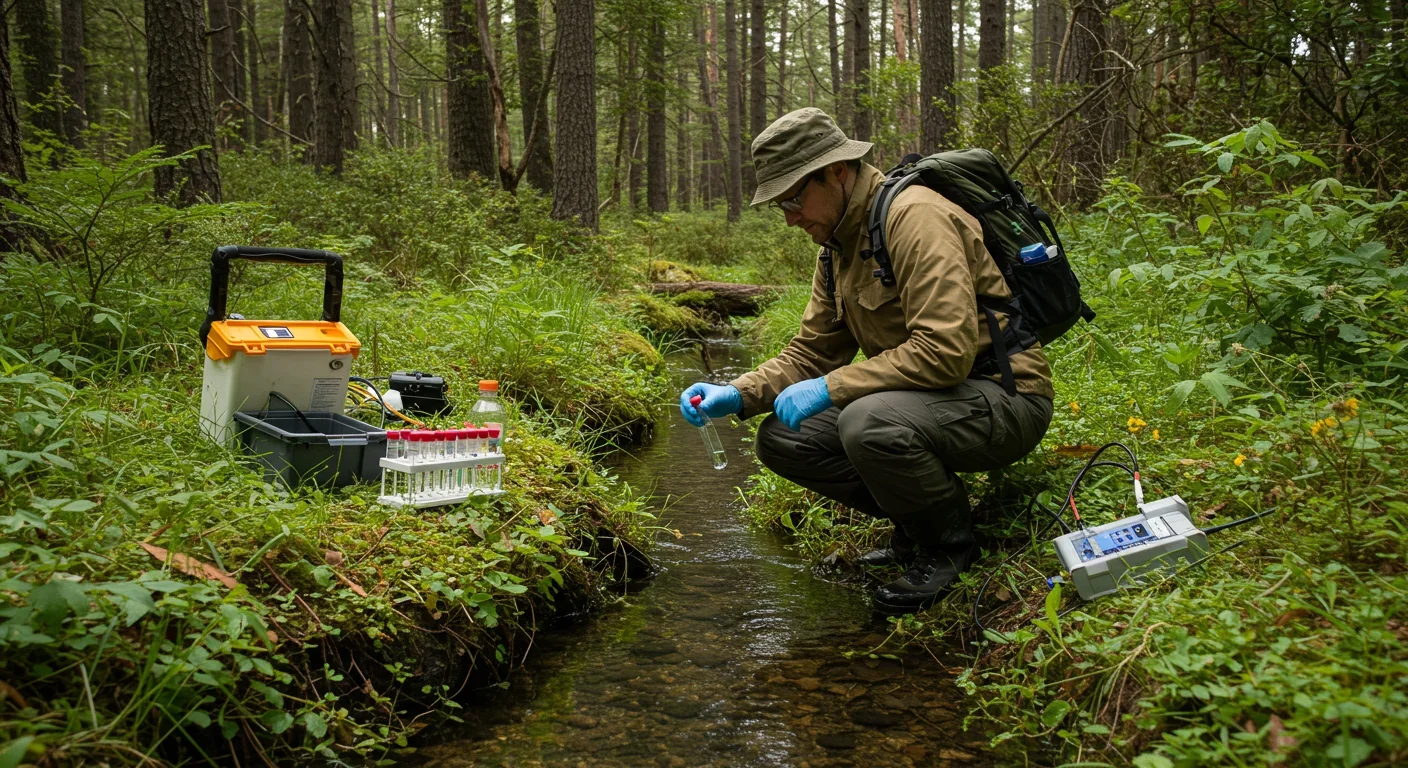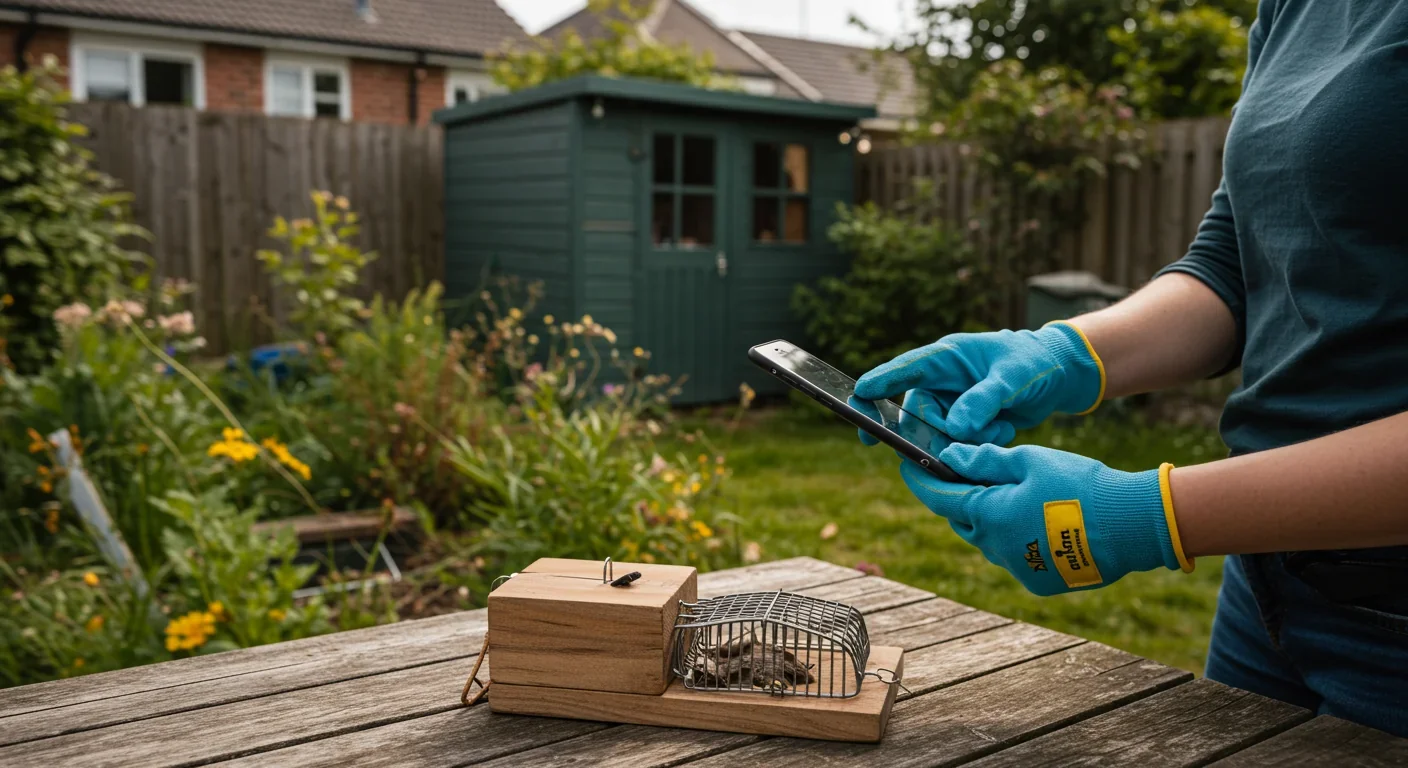Digital Pollution Tax: Can It Save Data Centers?

TL;DR: Invasive species threaten ecosystems worldwide, but humanity is fighting back with remarkable success. From biological control agents reducing invasive seeds by 98% to complete eradication programs on islands, we're developing sophisticated tools—eDNA detection, CRISPR gene editing, and community science networks—that prove we can restore damaged ecosystems.

A tiny wasp no bigger than a grain of rice just accomplished what decades of bulldozers and herbicide couldn't: it's taking down one of Earth's most aggressive plant invaders. In Portugal, researchers watched as Trichilogaster acaciaelongifoliae slashed seed production of invasive acacia trees by 98.1% in just six years. Meanwhile, halfway across the globe, New Zealand aims to eliminate every rat, stoat, and possum from its islands by 2050, a plan so audacious it sounds like science fiction, yet the early results show it's working. After centuries of ecological disasters caused by species we moved around the planet, humanity is finally learning how to push back—and win.
Invasive species don't arrive with fanfare. They slip through ballast water, hide in shipping containers, hitchhike in soil on travelers' shoes. But once established, they rewrite the rules of entire ecosystems. The Mediterranean Sea now hosts over 1,000 alien species, fundamentally altering food webs that have existed for millennia. Recent marine heatwaves have supercharged this invasion, with warming waters acting like an express highway for species that once couldn't survive the journey.
The tropics face an even more dramatic transformation. Invasive plants are rapidly changing tropical landscapes at a pace that forces entire communities to adapt their way of life. In Australia's Queensland, kudzu—the infamous "vine that ate the South" in America—now poses a major ecological threat to native forests. Back in the United States, Oklahoma State University researchers are tracking more kudzu sites as the plant continues its relentless spread.
The scale is staggering. According to the USGS, invasive species cost the U.S. economy more than $120 billion annually. They're the second-leading cause of biodiversity loss worldwide, trailing only habitat destruction. When an invasive species establishes itself, it doesn't just compete with native species—it can collapse entire food chains, alter soil chemistry, change fire regimes, and trigger cascading extinctions.
Some invasions become cautionary tales that reshape conservation strategy for generations. Cane toads in Australia stand as perhaps the most infamous example. Introduced in 1935 to control beetles in sugarcane fields, the toads ignored the beetles and instead became an unstoppable plague. They now number over 200 million, poisoning native predators with their toxic skin and advancing 40-60 kilometers per year. But recently, scientists discovered genes for toxin resistance in native wildlife, offering a glimmer of hope for targeted gene-editing interventions.
The Great Lakes tell another story of invasion on a massive scale. Zebra mussels arrived in ballast water in the 1980s and within a decade blanketed underwater surfaces by the billions. They filter so much plankton from the water that they've starved out native species while simultaneously making the water so clear that harmful algae blooms proliferate in the increased sunlight. The economic damage runs into billions for clogged water intake pipes alone, and ecosystems that evolved over 10,000 years have been fundamentally rewritten.
Lake ecosystems worldwide now face similar threats. Research on ecosystem services of lakes shows how invasive species disrupt everything from water purification to recreational value. Canada's efforts to protect species like the wavyrayed lampmussel demonstrate how invasive competitors can push native species toward extinction.
In the Mediterranean, the Suez Canal functions as a biological conveyor belt, delivering Red Sea species into a sea that never evolved defenses against them. Lionfish, native to the Indo-Pacific, have also established thriving populations in the Caribbean, where they devour juvenile fish with devastating efficiency, reducing native fish populations by up to 80% in some areas.
These disasters share common threads: human transport networks moving species faster than evolution can respond, lack of natural predators in new environments, and initial failures to recognize the threat until populations exploded beyond control.

Yet against this backdrop of ecological catastrophe, remarkable success stories are emerging. The war against invasive species is producing genuine victories that demonstrate humanity's growing sophistication in ecological restoration.
The Portuguese acacia project represents a textbook case of biological control done right. After years of study to ensure the gall wasp wouldn't harm native species, researchers released it in 2015. The wasp lays eggs inside acacia flower buds, creating galls that prevent seed formation. Within six years, seed rain dropped by 98.1%. Crucially, where the biocontrol agent established successfully and mechanical removal cleared adult trees, seed banks began stabilizing—the first step toward eventual ecosystem recovery. The study showed that combining biological control with targeted mechanical removal created synergistic effects neither approach could achieve alone.
New Zealand's Predator Free 2050 initiative takes the opposite approach: total elimination rather than biological control. The goal is to completely eradicate rats, stoats, and possums from the entire nation. It sounds impossible, but smaller-scale successes prove the concept works. In the Marshall Islands, after invasive rats were removed, seabird populations soared and native flora returned. The restoration created a cascade of recovery, with seabirds bringing nutrients from the ocean that enriched the soil and helped native plants outcompete invasive species. Seabird populations have shown dramatic increases across multiple species, validating the restoration approach.
These island victories demonstrate core principles: complete removal of invasives often works better than control, ecosystems have remarkable resilience when given a chance, and benefits cascade through entire food webs. New Zealand's Predator Free NZ Trust now coordinates thousands of community trapping efforts, creating a movement that combines cutting-edge science with grassroots participation.
Today's invasion biologists deploy an impressive array of technologies that would have seemed like fantasy two decades ago. These tools are changing the equation in humanity's favor.
Environmental DNA (eDNA) has revolutionized early detection. By filtering water samples and analyzing microscopic DNA fragments, scientists can now detect invasive species before they're established enough to see. The Great Barrier Reef uses eDNA to find invasive species in their earliest stages, when eradication is still possible. The USGS reports that eDNA can detect one invasive fish in a lake from a single water sample, identifying threats months or years before traditional surveys would find them.
CRISPR gene editing opens possibilities that blur the line between science and science fiction. Researchers have successfully edited the genome of cane toads in the lab, demonstrating that gene drives could theoretically spread sterility through wild populations. The technology raises profound ethical questions—explored in recent governance perspectives on genetically modified animals—but offers potential solutions to invasions that have resisted every other approach.
Improved ballast water monitoring addresses invasions at their source. New monitoring methods can detect viable organisms in ship ballast water before vessels discharge it, allowing international regulations to limit marine bioinvasions at points of entry. Ships now face strict treatment requirements before entering new waters, substantially reducing new introductions.
Predictive modeling powered by machine learning can forecast which species will become invasive and where. A recent study on predicting invasion potential demonstrates how climate models combined with species traits can identify high-risk scenarios before species are even transported. This allows preventive action rather than reactive crisis management.
Biological control has matured from a risky gamble to a precise science. Modern protocols involve years of host-specificity testing to ensure control agents won't harm non-target species. The Portuguese acacia case showed that when done right, biocontrol can achieve results that physical and chemical methods cannot sustain long-term.
Technology alone doesn't win this fight. Success requires people—millions of them—working together.
Community science programs like Invasives Canada turn ordinary citizens into the eyes and ears of early detection networks. When someone reports an unusual plant or animal through these platforms, they might be catching an invasion in its critical early window. The National Invasive Species Management Association coordinates efforts across the United States, connecting local groups with scientific expertise and resources.
In Belize, volunteers protect the barrier reef by monitoring and removing invasive lionfish. These community divers now remove thousands of lionfish annually, providing direct ecosystem benefits while generating data that guides regional response strategies. The Mesoamerican Reef system depends on this network of engaged communities to manage threats across national boundaries.
Policy frameworks increasingly recognize that invasive species don't respect borders. The European Union's Marine Strategy Framework Directive tracks alien species in the Mediterranean, requiring member states to monitor and manage invasions cooperatively. International regulations on marine bioinvasions show how policy can prevent invasions rather than merely responding to them.
The economics are shifting too. Nature's price tag research demonstrates that prevention costs a fraction of control, and control costs far less than living with established invasions. This economic reality is driving increased investment in border biosecurity and early detection programs.

As our tools become more powerful, the ethical questions grow more complex. Is it acceptable to engineer a gene drive that could extinguish an entire species, even an invasive one? Research reveals ethical grounds for eliminating specific harmful species, but where do we draw the line?
Consider the cane toad again. Gene-editing technology could theoretically make all cane toads sterile within a few generations. This would save countless native Australian animals and restore ecosystems. But it would also represent humanity intentionally extinguishing a species—setting a precedent that makes some biologists deeply uncomfortable.
The governance challenges around genetically modified organisms in ecosystems require new frameworks. Who decides if a gene drive should be released? What if it crosses borders? What are the long-term effects of removing a species that, despite being invasive in one location, is native and ecologically important elsewhere?
Research on non-target effects of control agents reminds us that even well-intentioned interventions can have unintended consequences. A pesticide targeting one species might harm beneficial insects. A biocontrol agent might occasionally feed on non-target plants. These trade-offs require careful weighing of benefits against risks.
There's also a question of responsibility. We caused these invasions through global trade and travel. Do we have an obligation to fix them, even if the methods are extreme? Or is there wisdom in accepting that some changes to ecosystems are now permanent parts of our globalized world?
The next decade will determine whether we can shift from reactive crisis management to proactive ecosystem defense. The tools exist. The question is whether we'll deploy them with sufficient speed and scale.
New identification and monitoring methods promise to catch invasions earlier. Machine learning algorithms can now scan satellite imagery to detect the spectral signatures of invasive plants before they're visible to ground observers. Acoustic monitoring can detect invasive animals from their calls. DNA in airborne dust can reveal the presence of invasive fungi.
Climate change adds urgency and complexity. Warming temperatures are expanding the range where tropical invasives can survive, while also stressing native ecosystems and making them more vulnerable to invasion. The record Mediterranean marine heatwave that drove a surge in invasive species offers a preview of future challenges. As climate zones shift, we'll need to predict not just current invasion risk but how that risk evolves over decades.
Success will require integration across multiple scales. Global trade rules need to prevent new introductions. National governments must fund border biosecurity and rapid response teams. Regional partnerships must coordinate management across jurisdictions. Local communities need resources and training to act as first responders. And individual choices matter—from properly cleaning boats between waterways to not releasing aquarium fish into local ponds.
The invasive species policy landscape is evolving to support this multilayered approach, with frameworks that allow rapid action when minutes count while ensuring scientific rigor guides long-term strategy.
Perhaps most remarkably, we're learning that ecosystems have profound resilience when given a chance. The Marshall Islands restoration shows that removing invasive species can trigger cascading recovery. Native plants rebound. Seabirds return. Soil chemistry shifts back toward historical baselines. These reversals aren't complete—some changes may be permanent—but they demonstrate that "invasive" doesn't always mean "irreversible."
Projects targeting invasive species across the United States are creating a network of restoration sites that serve as living laboratories. Each success teaches us more about what works, allowing us to refine techniques and apply them more broadly.
Australia's efforts to protect threatened species demonstrate that managing invasives is inseparable from broader conservation. Native species like those in the Threatened Species Thursday series face multiple pressures, and invasive species often represent the tipping point between persistence and extinction. Remove the invasive pressure, and native species often recover faster than expected.
Even challenging cases offer hope. Research on rice blast fungus spreading in the Indo-Pacific shows that early detection and coordinated response can contain agricultural invasives that threaten food security. The response to this threat demonstrates that the international community can mobilize quickly when the stakes are clear.
This isn't just a fight for scientists and policymakers. Individual actions aggregate into meaningful impact. Learn to identify invasive species in your region and report sightings to local programs. Clean your hiking boots between trails. Don't release pets or aquarium fish into the wild. Choose native plants for landscaping. Support organizations funding restoration work.
If you want to get directly involved, many regions offer volunteer opportunities for hands-on invasive species removal. These events combine physical work with education, connecting you to local ecosystems in tangible ways. The Reef Resilience project provides resources for communities working on marine invasive species, while Project Manaia coordinates Mediterranean efforts.
The fight against invasive species represents humanity at both its worst and best. We created this crisis through carelessness and exploitation of global trade networks. But we're also showing remarkable creativity, cooperation, and determination in fighting back. We're developing technologies that would have seemed impossible a generation ago. We're coordinating across borders and cultures. We're mobilizing millions of people to act.
The tiny wasp defeating the acacia invasion in Portugal isn't just a success story—it's a symbol of what's possible when we combine scientific rigor with ecological humility. We caused this problem, and we're learning how to fix it. The question isn't whether we can win individual battles against invasive species. We've proven we can. The question is whether we'll win enough of them, fast enough, to preserve the ecosystems we depend on. Based on the emerging pattern of successes, there's genuine reason for hope. The turning point may have already passed, and we're just beginning to realize we're winning.

Recent breakthroughs in fusion technology—including 351,000-gauss magnetic fields, AI-driven plasma diagnostics, and net energy gain at the National Ignition Facility—are transforming fusion propulsion from science fiction to engineering frontier. Scientists now have a realistic pathway to accelerate spacecraft to 10% of light speed, enabling a 43-year journey to Alpha Centauri. While challenges remain in miniaturization, neutron management, and sustained operation, the physics barriers have ...

Epigenetic clocks measure DNA methylation patterns to calculate biological age, which predicts disease risk up to 30 years before symptoms appear. Landmark studies show that accelerated epigenetic aging forecasts cardiovascular disease, diabetes, and neurodegeneration with remarkable accuracy. Lifestyle interventions—Mediterranean diet, structured exercise, quality sleep, stress management—can measurably reverse biological aging, reducing epigenetic age by 1-2 years within months. Commercial ...

Data centers consumed 415 terawatt-hours of electricity in 2024 and will nearly double that by 2030, driven by AI's insatiable energy appetite. Despite tech giants' renewable pledges, actual emissions are up to 662% higher than reported due to accounting loopholes. A digital pollution tax—similar to Europe's carbon border tariff—could finally force the industry to invest in efficiency technologies like liquid cooling, waste heat recovery, and time-matched renewable power, transforming volunta...

Humans are hardwired to see invisible agents—gods, ghosts, conspiracies—thanks to the Hyperactive Agency Detection Device (HADD), an evolutionary survival mechanism that favored false alarms over fatal misses. This cognitive bias, rooted in brain regions like the temporoparietal junction and medial prefrontal cortex, generates religious beliefs, animistic worldviews, and conspiracy theories across all cultures. Understanding HADD doesn't eliminate belief, but it helps us recognize when our pa...

The bombardier beetle has perfected a chemical defense system that human engineers are still trying to replicate: a two-chamber micro-combustion engine that mixes hydroquinone and hydrogen peroxide to create explosive 100°C sprays at up to 500 pulses per second, aimed with 270-degree precision. This tiny insect's biochemical marvel is inspiring revolutionary technologies in aerospace propulsion, pharmaceutical delivery, and fire suppression. By 2030, beetle-inspired systems could position sat...

The U.S. faces a catastrophic care worker shortage driven by poverty-level wages, overwhelming burnout, and systemic undervaluation. With 99% of nursing homes hiring and 9.7 million openings projected by 2034, the crisis threatens patient safety, family stability, and economic productivity. Evidence-based solutions—wage reforms, streamlined training, technology integration, and policy enforcement—exist and work, but require sustained political will and cultural recognition that caregiving is ...

Every major AI model was trained on copyrighted text scraped without permission, triggering billion-dollar lawsuits and forcing a reckoning between innovation and creator rights. The future depends on finding balance between transformative AI development and fair compensation for the people whose work fuels it.